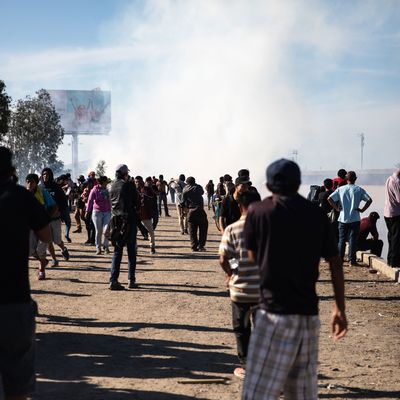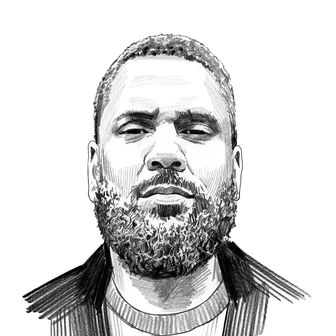
A protest on Sunday staged by Central American migrants erupted in violence at the U.S.-Mexico border at San Ysidro. Hundreds scrambled through car lanes and up fences in a rush for California soil. Others threw rocks and bottles. U.S. authorities responded by closing the point of entry for hours, firing tear-gas canisters into Mexico and engulfing the migrants — including women and small children not involved in the clashes — in clouds of noxious chemicals. Observers condemned the border agents’ conduct. “Border Patrol firing tear gas on asylum seekers, including kids,” tweeted Representative David Cicilline of Rhode Island. “This is not America.” President Donald Trump, who orchestrated the violence, was unmoved. “Mexico should move the flag waving migrants, many of whom are stone cold criminals, back to their countries,” he tweeted on Monday. “We will close the border permanently if need be. Congress, fund the wall!”
Trump and his supporters in the Republican Party and conservative media have spent weeks insisting on the threat posed by these migrants, who made their way north by the thousands — mostly from Honduras — to escape violence, corruption, and economic hardship at home. But the presence of small children among them has undercut the conservative fiction that they are an army of killers and terrorists funded by Venezuela. Critics have highlighted this contradiction, though their pleas have failed to sway the brutalizers. “Bum-rushing the border is a choice and has consequences,” tweeted pundit Tomi Lahren, in a characteristic retort. “Watching the USA finally defend our borders was the highlight of my Thanksgiving weekend.”
The right has repeatedly made it clear that children are fair game in the administration’s violent crackdowns on immigrants, including through Trump’s draconian child-separation policy. But contrary to Cicilline’s claim, and in keeping with Lahren’s, such brutality is far from un-American. Committing violence against children is an age-old tactic used by U.S. authorities and their citizen allies to deter the children’s elders from demanding human rights. The most vulnerable to these attacks have frequently been those whose claims to citizenship were precarious, if not under active dispute or being denied outright.
Sunday’s violence continued this dynamic, though American brutality against migrants is not unique to Trump. In 2013, Border Patrol agents pepper-sprayed a group of about 100 who rushed the border at San Ysidro. Obama was president then. But Trump’s policies are widely seen as a dramatic escalation, including by standardizing the separation of immigrant children from their parents when they cross the border undocumented. Many observers have pointed out, correctly, that the historical precedent for this includes the sale of enslaved black children taken away from their families in the antebellum South, and the forced separation and enrollment of Native American children in assimilationist boarding schools between the 1870s and 1970s. But attacking children to quell dissent is equally central to U.S. history. During the lynching era, violence against black youth signaled to their communities the perils of challenging the racial order. After allegedly “frightening” a white woman in 1889, Warren Powell was lynched in East Point, Georgia, at age 14. In 1911, L.D. Nelson, also 14, was lynched in Okemah, Oklahoma, along with his mother Laura, after he was accused of killing a sheriff’s deputy. Their bodies were hanged from a bridge over the North Canadian River. A white woman in 1955 lied about 14-year-old Emmett Till making physical advances on her, prompting her husband and brother-in-law to kidnap, beat, mutilate, and shoot the child in the head before tying his corpse to a cotton-gin fan and sinking it in Mississippi’s Tallahatchie River. All three were warnings to other black would-be transgressors.
But the way in which the tactics used against adults were mobilized against children involved in organized dissent finds its clearest parallels in the civil-rights movement. During the first week of May, 1963, several thousand black schoolchildren took to the streets of Birmingham, Alabama, to protest segregation in the city’s businesses and public spaces, in what became known as the Birmingham children’s crusade. The demonstration was the brainchild of Reverend James Bevel, leader of the Southern Christian Leadership Conference, who felt the image of children facing down Jim Crow’s brutal agents might turn the tide of the movement. He was right. On the first day of the protests, May 2, roughly 500 children were rounded up in paddy wagons and locked in jail, some confined to cells packed with 75 people that were meant to hold eight.
The next day, Bull Connor, the city’s public safety commissioner, ordered attack dogs and fire hoses unleashed on the children. Rocketing water streams “were driven across [their] bodies, lacerating their flesh, tearing clothing off their backs; hitting the elm trees in nearby Kelly Ingram Park, the blasts ripped off the bark,” wrote Steven Levingston, author of Kennedy and King: The President, the Pastor, and the Battle Over Civil Rights, in the Washington Post. “The children, knocked to the pavement, crawled away; some struggled to their feet with bloody noses and gashes on their faces.” The incident drew national attention and is credited with spurring President John F. Kennedy’s support for civil-rights legislation. It also galvanized new activists. “What really sticks in my mind then and sticks in my mind now is seeing a K-9 dog being sicced on a 6-year-old girl,” said Andrew Marrisett, a Birmingham local turned SCLC staffer, in My Soul Is Rested, an oral history of the movement. “That really was the spark … a big, burly, 285-pound cop siccing a trained police dog on that little girl, little black girl. And then I got really involved in the movement.” But the costs were steep as well. The 16th Street Baptist Church, from which the children’s crusade was staged, was targeted by Klansmen that September in a bombing attack that killed four young girls — Addie Mae Collins, Carole Robertson, Cynthia Wesley, and Denise McNair.
The children in Birmingham then were agitating against a system that refused to treat them as full citizens. The migrants’ protest and incursion at San Ysidro over the weekend was a response, most immediately, to the U.S. government restricting their avenues for legal entry and potential citizenship. Trump tried earlier this month to render many who enter the U.S. without documents ineligible for asylum, regardless of their claims’ validity. A federal judge in San Francisco blocked the rule on November 9, pending determination of its legality by a court. But the administration has not stopped signaling its hostility. Trump has treated this latest wave like an invasion, publicly claiming — without evidence — that the group is full of criminals and “unknown Middle Easterners,” a dog whistle for “terrorists.” He has sent thousands of U.S. troops to the border in a show of force meant transparently to evoke siege and drive Republican voter turnout. Last week, a memo signed by Trump’s chief of staff, John Kelly, was made public authorizing troops to use “lethal force, where necessary.”
All of this compounds the reasons for the migrants’ initial flight from home. Amid spiking murder rates and endemic poverty, a 2009 military coup — which was later validated by the United States — preceded several elections whose legitimacy was disputed by many Hondurans. The first occurred the same year, and took place under military rule after basic civil rights — including freedom of speech and the press — had been suspended. “[The] U.S.’s recognition of what many in the country deemed as an illegitimate election, is what some in my family believe is the catalyst for this mass exodus,” wrote ABC News’ Victoria Moll-Ramirez, who is Honduran-American and has dozens of family members still living in Honduras, in October.
Facing a dead-end back home and narrowing legal channels to secure rights at the U.S. border, protest has become one of the few options migrants have left. Right-wing insistence that they simply follow the rules to gain entry belies the rules’ inadequacy for addressing the actual problems they are meant to confront. Death and despair await back home. Mexican cities like Tijuana have proven logistically incapable of housing the travelers long term. Waiting years for asylum claims to be processed is often untenable. Desperation festers under such circumstances. Insisting they have rights, via protests, is among the few logical responses. That the U.S. government sees fit to punish them for it — including by tear-gassing their children, or abducting them and locking them in cages — casts their claims in stark moral terms. But more than that, it affirms Americans’ legacy of using violence against the young as a deterrent to agitating adults. Black and Native people have long been kept in line because the alternative was watching their children suffer or die — and in the 1960s, it took widely disseminated imagery of that suffering to convince many Americans on which side of history they should stand. The president was among those Americans back then, but in 2018, no such recourse awaits. The president himself is now the primary engine driving the violence. A turning point like what Bevel foresaw in Birmingham is an unlikely prospect today.






























